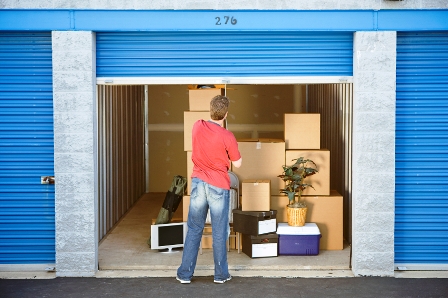Guest Post From SelfStorageDeals.com: Finding the Right Storage Unit for Your Move
Today we're featuring a guest post from our friends over at SelfStorageDeals.com:
Planning a move can feel like a juggling act, with your family, your pets, and your possessions all up in the air at the same time. Wouldn’t it be nice if someone could hold on to one of these while you take care of the others?
Without begging or borrowing space, you’re going to have to look to the storage specialists: self-storage facilities. For a fee, it’s possible to rent the necessary space to keep a portion of your possessions outside of the equation while you manage your complicated move. But while a cheap self-storage unit can add stability and a sense of security during this turbulent period of your life, finding the right unit comes with its own set of calculations. Storage units come in sizes from “junior high locker” to 10’ x 20’ units as large as a full garage — rent one that’s too small and you’ll run out of space; go with a unit too big and you’ll be overpaying. So how do you determine which size unit is right for you?

Take Inventory. Packing a storage unit is not the same as packing a moving truck. Moving trucks are used for single trips, transporting as much stuff as fits in the truck from one place to another and then unloading. Storage units are rented out for months at a time, and during that time it’s very likely that you might need to access some of your possessions. This means that there will be two organizing principles to how you arrange your storage unit: 1) fitting things together to maximize your use of space (as you would with a moving truck) and 2) making sure that items you might need to access are accessible. So take inventory and classify accordingly.
Visit the Facility. If you can find the time, head out to the facility and examine various sizes of units. The most important factor here is height: while the square footage of floorspace is generally standard (5x5, 5x10, 10x10, 10x15 and 10x20 being the standard sizes), height ranges between 8-12 feet for a storage unit, which can equal very different volumes. Visiting the facility will allow you to fully picture the unit’s size, but even if you’re unable to visit make sure to contact the facility to find out about ceiling height. Stay away from “storage lockers,” which are sometimes available in storage facilities in metropolitan areas. These lockers are substantially cheaper because they are only 4-6 feet high.
Set up a model. Find a space in your home—preferably near your door, as you’ll be moving these items out with you—and experiment with the formation you might want to use in your unit. Using a uniform box size can make planning easier. Items that can be tightly-packed should go into boxes, with the heaviest pieces at the bottom. Items you might need to access can also be boxed—just make sure they stay at the top, within your reach. Tightly pack the back corners of your simulated unit with items you won’t need to get to. Those you’ll want to access should go towards the front of the unit on top of each stack. If you have a large number of items that you know you’ll need to access, you might want to leave a walking path that divides the unit into two halves. In such a case it’s likely true that you won’t be able to stack items as high either, so in general the more items you’ll have to access the more space you’ll end up needing.
Awkwardly-shaped items should be placed on top of boxes and away from corners when possible, as squares are the most efficient use of space. Disassemble all furniture that can be and then stack the pieces vertically on their sides. Remember that refrigerators, drawers and cabinets can be filled as well.
Here’s a rough guide to storage unit sizes:
5x5: same as a small closet; good for chairs, boxes, cabinets and electronics.
5x10: size of a walk-in closet; good for the contents of a 1-bedroom apartment.
10x10: size of a large bedroom; good for the contents of a 2-bedroom apartment.
10x15: size of a 1-car garage; good for the contents of a 2-3 bedroom house.
10x20: size of a 2-car garage; good for the contents of a 4-bedroom home.
Once you set up a model that you’re satisfied with, take a picture so you remember what went where. Then it’s time to load up that truck and take your possessions to their new, temporary home.
Brian Shreckengast is a writer at SelfStorageDeals.com, the price-focused search engine for finding cheap self-storage units. Learn more about storing and how to do it for cheap at the Self Storage Blog.
